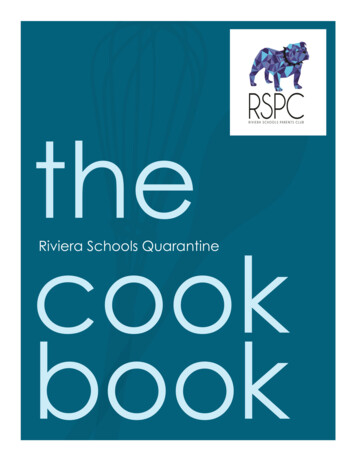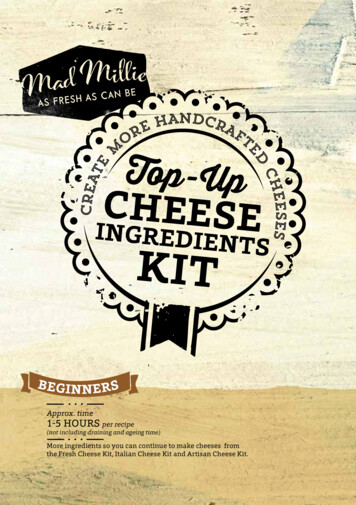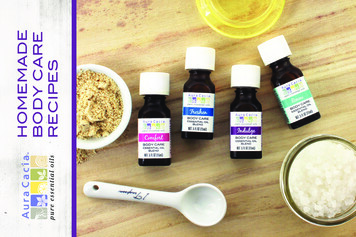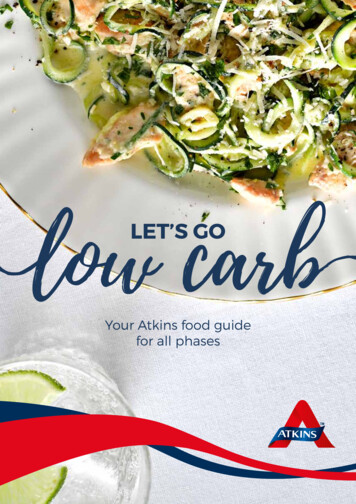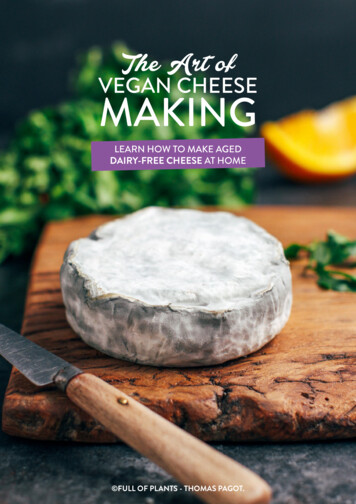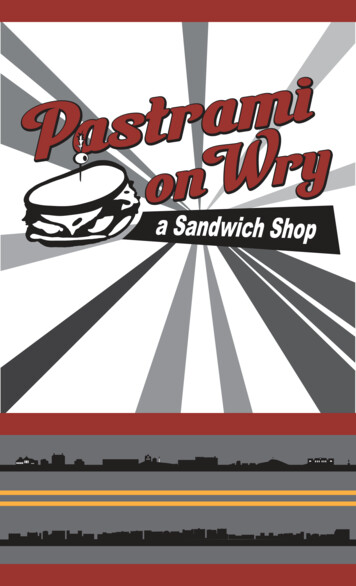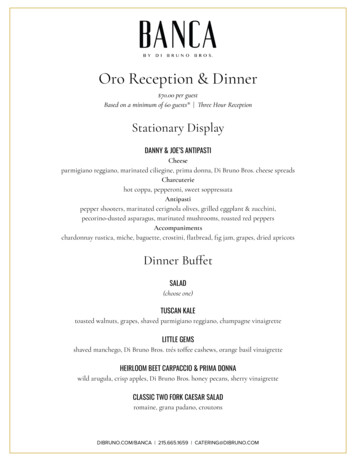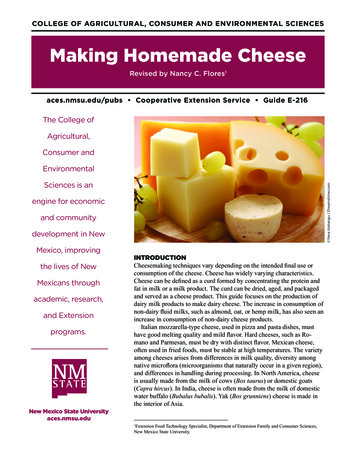
Transcription
COLLEGE OF AGRICULTURAL, CONSUMER AND ENVIRONMENTAL SCIENCESMaking Homemade CheeseRevised by Nancy C. Flores1aces.nmsu.edu/pubs Cooperative Extension Service Guide E-216The College ofAgricultural,Consumer andEnvironmental Yana Kabangu Dreamstime.comSciences is anengine for economicand communitydevelopment in NewMexico, improvingthe lives of NewMexicans throughacademic, research,and Extensionprograms.New Mexico State Universityaces.nmsu.eduINTRODUCTIONCheesemaking techniques vary depending on the intended final use orconsumption of the cheese. Cheese has widely varying characteristics.Cheese can be defined as a curd formed by concentrating the protein andfat in milk or a milk product. The curd can be dried, aged, and packagedand served as a cheese product. This guide focuses on the production ofdairy milk products to make dairy cheese. The increase in consumption ofnon-dairy fluid milks, such as almond, oat, or hemp milk, has also seen anincrease in consumption of non-dairy cheese products.Italian mozzarella-type cheese, used in pizza and pasta dishes, musthave good melting quality and mild flavor. Hard cheeses, such as Romano and Parmesan, must be dry with distinct flavor. Mexican cheese,often used in fried foods, must be stable at high temperatures. The varietyamong cheeses arises from differences in milk quality, diversity amongnative microflora (microorganisms that naturally occur in a given region),and differences in handling during processing. In North America, cheeseis usually made from the milk of cows (Bos taurus) or domestic goats(Capra hircus). In India, cheese is often made from the milk of domesticwater buffalo (Bubalus bubalis). Yak (Bos grunniens) cheese is made inthe interior of Asia.Extension Food Technology Specialist, Department of Extension Family and Consumer Sciences,New Mexico State University.1
Figure 1A. Adding diluted rennetand calcium chloride to warmcultured milk.Figure 1B. Cutting the curd.Figure 1D. Separating curds from whey.Cow’s milk (whole milk) consists of 88% water,3.25% fat, 3.25% protein, 4.8% sugar (lactose), and0.7% minerals and vitamins (USDA, 2005). The cheesemaking process involves forming a curd from milksolids, such as fats, protein, and minerals, that areseparated from the liquid milk and concentrated (Hill,2006). The discharged liquid, a yellowy liquid knownas whey, contains most of the water, lactose, simpleproteins, minerals, and vitamins (Hill, 2006). About10 pounds (1.25 gallons) of milk are required to makeone pound of cheese.Making cheese is a dynamic process that is affectedby time, temperature, and the bacterial culture (lacticacid bacteria) and coagulating enzyme (rennet) thatare used to concentrate and separate the casein (milkFigure 1C. Cut curd floating in whey.protein) and fat from the whey. Exceptions to thisinclude cheeses such as queso fresco or queso blanco(traditionally eaten in Latin American countries) andpaneer (traditionally eaten in India), which are madewithout bacterial cultures or rennet. These cheeses aremade by curdling hot milk by adding an acid such asvinegar or fruit juice (like lemon juice). This type offresh cheese is simple to make and has a higher yieldbecause all the whey proteins normally lost are included in the cheese.The enzyme rennet causes casein to form chainsand to develop a mesh-like network or gel, trappingwater and fat (Figure 1A). This semisolid gel is thecurd. When the gel is firm enough, it is cut into smallpieces (Figures 1B and 1C) and, after cooking, thewhey is removed (Figure 1D). The whey may be partially drained from the curd and the curd washed withwater to increase its moisture content. The temperature during cooking and handling of the curd affectsthe texture of the curd and the type of final product.When the curd has reached the desired moisture andacidity, salt can be added. Salting may be achievedthrough brine, as with Gouda; surface salt, as withfeta; or dry salt, as with cheddar. After salting, thecurd may be partially drained and again washed withwater to increase the moisture content. When thecurds have reached the desired moisture and acidity(pH), the whey is separated from the curd.The cheese curd formed is a result of bacteriaconverting lactose into lactic acid. The acid acts asa preservative, removes water from the cheese curd,Guide E-216 Page 2
and develops cheese texture (Hill, 2006). Initially, theenzymes from native microflora produce the flavorcomponents, which change during aging.Commercial cultures have been developed toproduce a particular cheese type. Cultures can bepurchased by consumers to make specialized cheeseproducts; a list of cheesemaking supply companiesand other resources can be found at the end of thisguide. However, cultured yogurt and buttermilk alsocontain live bacteria that can be used as a culture tomake cheese.Once the whey is removed, the curd is allowed tostick together, forming a mat. The mat is transferred toa hoop or mold lined with cheesecloth, which contributes to the final shape. The mold can be pressed to forma dense cheese (like cheddar) or can be left to settle under its own weight to have an open texture (like feta).Soft cheeses can be made at home without specialized equipment. Because soft cheese contains over45% water, it is highly perishable and has a refrigerated life of only five to seven days.FOOD SAFETY CONCERNSThere are four major pathogens associated with freshcheese, all of which can cause foodborne illness. Theyare Salmonella spp., Escherichia coli, Listeria monocytogenes, and Staphylococcus aureus. These pathogenic bacteria can be controlled by good sanitation ofequipment and food contact surfaces, proper cooking,proper cooling and handling of cheese curds duringprocessing, and proper hand washing.Sanitation1. Wash hands properly with soap and water, thendry completely with a disposable towel.2. All equipment must be washed with detergent andwater before and after use.3. Rinse all equipment with clean, potable water toremove all soapy residue.4. Boil all cheesemaking equipment between uses.5. Soak all cheesemaking equipment in a bleachwater solution for 2 minutes before and afteruse. Maintain active chlorine in bleach-water(see below).6. For the best-quality cheese, use new cheeseclotheach time you make cheese. (Sterilize cheeseclothby first washing in dish soap, rinsing well to remove soap, then soaking in boiling water, or soaking for 2 minutes in bleach-water. See recipe forbleach-water below.)7. Squeaky clean is clean. If you can feel a residueon the equipment, it is not clean.Wash hands after touching dirty or soiled surfaces,after sneezing or coughing, after using the bathroom,after eating, or after handling raw milk.Bleach-water Add 1 tablespoon of standard, unscented householdbleach to 1 gallon of water. Make a new bleach-water solution each time youmake cheese. Test the chlorine activity of bleach-water on a regular basis using litmus test paper (available at hardware stores). Remake bleach-water if it becomes cloudy withfood particles. Bleach-water recipe can be doubled if necessary.Pasteurization of raw milkRaw milk is not necessary for the recipes presented inthis document. However, if starting with raw milk, itmust be pasteurized. The pasteurization of raw milkis a delicate procedure dependent on temperature andtime. It is recommended that the raw milk be pasteurized by heating to 140–145 F (60–62.8 C) and stirredfor 30 minutes of heating time. This heat treatmentwill destroy pathogenic bacteria that could causefoodborne illness. After pasteurization, the milk iscooled by removing from the heating element. Coolthe milk to 89.6–98.6 F (32–37 C). Then the milk canbe used for cheesemaking. Use a cooking thermometer in the milk tomeasure temperature. Temperature control isvery important. Do not heat milk over 145 F (62.8 C). It maychange the texture and flavor of the cheese.Temperatures under 140 F (60 C) will not killharmful bacteria.Note: Pasteurized milk available at thegrocery store has been heat processed andhomogenized for a ready-to-drink milk product. This affects milk protein and fat texture.Although homogenized milk can be used, theresulting cheese will have a different texturethan the traditional cheese.Guide E-216 Page 3
Table 1. Fat Content of Common Milk Products(USDA, 2019)Grams of fat/cupDairy product(g/ 240 g)Whole milk82% milk51% milk2.3Skim milk0.2Condensed milk27Buttermilk, whole8.1Half and half28Heavy cream87Light cream46Yogurt, Greek, plain, non-fat0.4 (g/100g)Yogurt, plain, low-fat3.8Yogurt, plain, whole8.0SELECTING MILK ANDCULTURE PRODUCTS (FIGURE 2)The quality of the cheese depends highly on the quality of the milk and cultures used to make the cheese.Quality is affected by freshness, or age and microbialstatus of the milk, and by the health of the dairy cow.Cultures, as already mentioned, can be obtained directly from a supplier or indirectly from yogurt or buttermilk. Regardless of the source of milk and cultures,care must be taken to handle the cultures properly toprevent microbial contamination that may affect theactions of the culturing agent.The texture and flavor of cheese are determined initially by the culturing agents, by the fat content of themilk product used, and by the amount of moisture leftin the product. The milk products used in cheesemaking contribute both fat and moisture. Therefore, whenthe goal is to make a low-fat cheese, it is important toconsider that the flavor, texture, and moisture contentof a cheese made from low-fat milk will be much different than a cheese product with a higher fat content.Table 1 provides information on the fat content of various milk products that can be used in making cheese.CulturesCultures are added to fresh milk as a freeze-driedpowder or cultured milk product. The freeze-driedpowdered culture must be added directly to warm(90 F; 32.2 C) fresh milk, and time should be allowedfor the powder to hydrate in the milk. Care must betaken to protect cultures from contamination.Calcium chlorideCalcium chloride can be used to condition homogenized milk so that a heavier or more dense curd canbe formed with longer protein chains. The process ofhomogenization is used to make dairy milk a smootherbeverage to consume as a drink. Calcium chlorideshould not be used to make mozzarella cheese becauseit causes a loss of elasticity of the curd (Ismail, 2008).Calcium chloride liquid is diluted in distilled water andis added to cultured milk before rennet is added.Cheese made with rennetRennet is available as a tablet or liquid. One teaspoonof liquid rennet is equivalent to one tablet. Eitherform must be completely dissolved in cool distilled orboiled water. Hard water must be neutralized by adding 1/4 cup milk to water before adding the rennet.EQUIPMENT FOR MAKING SOFT CHEESE(FIGURE 3) Thermometer with a temperature range of40–165 F (4.4–74 C). Large double boiler with about a 5-quart capacityfor 1 gallon of milk. (Two large cooking pots ofdifferent sizes can be substituted for adouble boiler.) Spatula long enough to reach the bottom of thedouble boiler. Long-handled spoon. Long-bladed knife. Digital timer or easy-to-read clock. Measuring cups and measuring spoons(1/8 and 1/4 teaspoons). Cheesecloth or muslin, tea towel. Quart strainer to support draining cloth. Forms or molds for shaping the cheese. A press or device to put pressure on the cheese.A homemade press can be made from a panshaped colander and a salad plate or a “follower.”A 1-pound coffee can (smooth-sided) can also beused. Cans or glass jars that fit snugly in the coffeecan be used as a press. Punch holes in the bottom ofthe can from the inside out so a cloth liner will notcatch on the metal edges. Make a follower out ofthe can lid in the same way. Brining container made of glass or heavy plastic. Plastic bucket (2-gallon capacity) forwhey discharge.Guide E-216 Page 4
Figure 2. Cheese cultures, tablet and liquid rennets, and calcium chloride are available from online cheesemaking stores.Figure 3. Common household supplies for cheesemaking at home (see list in text).Guide E-216 Page 5
RecipesNo-rennet QuesoBlanco (Latin American White Cheese)Recipe adapted from Hill (2006)Heat-acid or no-rennet quesoblanco is a white, semi-hardcheese made without cultureor rennet. It is eaten fresh andmay be flavored with peppers,herbs, and spices. It is considered a “frying cheese,” meaning it does not melt and canbe deep fried or grilled. Quesoblanco can also be made byrenneting whole milk with littleor no bacterial culture.Ingredients (Figure 4): 1.0 gallon (3.76 L; 8 lb;Figure 4. Ingredients used to make white cheese (queso blanco): table salt,3.63 kg) heat-treated orwhole milk, white vinegar, distilled water.pasteurized milk 4.6 fl oz (137 mL) vinegar(5% acidity)3. Separate the curd by filtering through a cloth bag 9.2 fl oz (274 mL) distilled wateruntil free whey is removed. 1 teaspoon (4.6 g) salt4.Open cheese bag and add in salt and spices to Spices to tastetaste by gently kneading curds.Procedure:5. Close cheese bag and gently press out any1. Heat milk to 176 F (80 C) for 20 minutes.remaining whey.2. Add the vinegar (5% acidity) to the distilled wa6. Remove cheese curds and place intoter, then slowly add the vinegar/water mixture toboilable bags.the hot milk until the whey is semi-clear and the7. Package curd in sealed bags (vacuum package ifcurd particles begin to mat together and becomepossible) and place in boiling water for 5 minutesslightly stretchy. You should be able to stretch ato sterilize the surface and prevent mold growth.piece of curd about 0.39 inches (1 cm) before it8. Queso blanco may keep for several weeks if propbreaks. It may not be necessary to add all of theerly packed and stored in a refrigerator, but shouldvinegar mixture.be eaten as fresh as possible.Guide E-216 Page 6
SAFE Queso Fresco(Fresh Cheese)Recipe adapted from “Abuelaproject,” Washington StateUniversity (2002)This recipe was designed to replace queso fresco made with rawmilk after an increase in Salmonella outbreaks in Yakima County,Washington. Queso fresco has agrainy, soft, crumbly texture and amild, fresh flavor. This cheese canbe eaten in crumbly pieces in salads, but holds up well to heating,both baking and broiling.Ingredients (Figure 5): 1 quart (0.95 L; 2.15 lb; 911 g)cultured buttermilk for culture 2 quarts (1.89 L; 4.3 lb; 1.9 kg)heat-treated or pasteurized milk 7 teaspoons (35 mL) white vinegar (5% acidity) 1 tablet rennet or 1 teaspoonliquid rennet, dissolved in1/2 cup water 2 teaspoons (9.3 g) saltFigure 5. Ingredients used to make queso fresco: table salt, whole milk, buttermilk, white vinegar, liquid rennet.Procedure:1. Mix 1 quart cultured buttermilk with 2 quartsheat-treated or pasteurized milk.2. Add 7 teaspoons white vinegar (5% acidity) to themilk mixture and mix well.3. Heat milk to 90 F (32.2 C). Remove pan from heat.4. Add dissolved rennet and mix for about 2 minutes.5. Let stand for 30–40 minutes until curd is firm.6. Cut curd into 1-inch (2.5-cm) cubes and let standfor about 5 minutes.7. Heat curds and whey to 115 F (46.1 C)without stirring.8. Remove pan from heat, then let stand for 5 minutes.9. Pour curds/whey mixture through cheesecloth andallow whey to drain for 5 minutes.10. Form curd into a ball and twist the cheeseclothgently to squeeze out the whey.11. Break up curds into a bowl and add2 teaspoons salt.12. Mix in salt and let stand for 5 minutes, thensqueeze again as before.13. Place curd in a mold to form the cheese, andallow to stand overnight in the refrigerator.14. Remove cheese from mold and package in anairtight container.15. Keep cheese refrigerated during storage.Guide E-216 Page 7
Figure 6A. Cream cheese draining in cheesecloth on topof plastic mold in bowl to recover whey.Figure 6B. Cream cheese after draining whey.Cream CheeseRecipe adapted from McDaniel and Kendall (2004)Cream cheese has a mild, smooth texture and a slightcitrus flavor balanced with buttery cream. Cream cheesecan be blended with fruit and seasonings, used as a dipor spread, or used in desserts such as cheesecake.Ingredients: 3 1/2 quarts (3.3 L; 6.45 lb; 2.92 kg) pasteurizedwhole milk 1 pint (473.2 mL; 238.4 g) pasteurizedwhipping cream 3/4 to 1 cup (6–8 fl oz; 177 mL; 242 g) freshbuttermilk for culture 1 tablet rennet or 1 teaspoon liquid rennet,dissolved in 1/2 cup water 1 1/2 teaspoons (7.12 g) salt (optional)Procedure:1. Add milk, cream, and buttermilk to the upper partof a double boiler. Add enough water in the bot-2.3.4.5.6.7.8.tom of double boiler to prevent milk mixture fromscorching. Warm to 85 F (29.4 C).Add dissolved rennet, then stir gently for4 minutes.Cover the milk mixture and let stand for 1 houror until the whey covers the curd and the curdbreaks cleanly from the side of the pan. Maintaina temperature of 85 F (29.4 C) while the milkmixture stands.Cut curd into 1-inch (2.5-cm) cubes and allow tostand undisturbed for 5 minutes.Pour mixture into a muslin bag or cheeseclothlined colander with a large pot to catch wheydrained away from the curd. Place apparatus inthe refrigerator overnight (Figures 6A and 6B).With a wooden spoon, work 1 1/2 teaspoons saltinto the drained curds.Remove curds from cheesecloth or bag and placecurds in clean sealable freezer bag.Store packaged cream cheese in the refrigeratoruntil ready for use.Guide E-216 Page 8
“Feta-style” Fresh CheeseFeta is a crumbly, salty, tangy cheese originating inGreece. It is commonly eaten fresh in salads, but isalso used in Greek phyllo dough pastries. “Feta” is aprotected designation term of origin by the EuropeanUnion, which means only cheese products made following traditional methods in mainland Greece can becalled “feta.”Ingredients: 2 to 3 gallons (7.59–11.37 L; 17.2–25.8 lb; 7.8–11.7 kg)whole milk, pasteurized and non-homogenized 1/4 teaspoon MT1 starter culture (mesophilic) 1 rennet tablet or 1 teaspoon rennet, dissolved in 1/2cup of water 8 tablespoons salt per 1 gallon whey to makewhey brineProcedure1. Heat milk to 90 F (32.2 C) over approximately30 minutes. Stir milk occasionally until reachingtarget temperature. Remove from heat source andtransfer to holding table.2. Sprinkle culture over milk surface and allow todissolve for 2–4 minutes before stirring. Stir with20 top-to-bottom strokes. Let sit for 2 hours.3. Add dissolved rennet and stir in with 15 top-tobottom strokes. DO NOT OVER-BLEND. Letcurd sit for 7–10 minutes.4. After 7–10 minutes, test curd for clean break—LOOK for custardy consistency. If curd does notbreak cleanly, allow to sit until clean break isachieved. Check curd every 5 minutes.5. Using a clean long knife blade, cut into 1/4-inch(0.6-cm) cubes. Let sit for 10 minutes.6. Gently stir cut cubes or curds for 1 minute.7. Allow curds to settle to bottom of pot. Removewhey from pot and reserve whey in anotherlarger pot.8. Add enough salt to the whey to make a 3.5%brine solution (approximately 8 tablespoons saltper 1 gallon whey); heat whey brine to150 F (65.5 C).9. Slowly add curds to hot brine 1 cup at a timewhile gently stirring. This should take about15–20 minutes.10. Have cold distilled water available to cool curds ifneeded to reduce temperature to 118 F (47.8 C).11. Float curds in the whey brine at 118 F (47.8 C)for 15 minutes.Figure 7A. Feta cheese in molds in plastic containersdraining whey.Figure 7B. Adding salt and flavoring to feta cheese.12. Scoop curds using a perforated spoon to transfercurd to plastic molds (Figure 7A). Fill to the topand press lightly over another container to catchdraining whey. Stack molds and press lightly.13. Remove curds from molds and cut cheese into1-inch chunks. Add more salt if desired (1 teaspoon per pound of curd). Season as desired withherbs, chile pepper, or other spices (Figure 7B).14. Cheese can be transferred to molds to shape, orpackaged into containers with lids. Can be eatenfresh, or allowed to age as long as desired.Guide E-216 Page 9
NeufchâtelRecipe adapted from McDaniel and Kendall (2004)Neufchâtel (new-sha-TEL) is a milky-white cheesewith a soft, smooth texture, and is low in fat if madewith reduced-fat or fat-free milk.Ingredients: 1 gallon (3.79 L; 8.6 lb; 3.9 kg) pasteurized milk(any level of fat) 1/2 cup (4 fl oz; 114 g) fresh cultured unsalted buttermilk OR 1/4 cup (2 fl oz; 57 g) fresh plain yogurtfor culture 1 tablet rennet or 1 teaspoon liquid rennet, dissolvedin 1/2 cup water 1 to 3 teaspoons (4.5–14 g) salt; at least one teaspoon salt is needed to form the cheese curdProcedure:1. Add 1 gallon of milk to the upper part of a doubleboiler. Add enough water in the bottom of doubleboiler to prevent milk from scorching. Stir in buttermilk or yogurt and warm slowly to 92–94 F(33.3–34.4 C). Maintain this temperature rangethrough Steps 2 and 3.2. Add dissolved rennet to milk mixture and stir for2–3 minutes. Allow milk to sit undisturbed forabout 30 minutes or until a firm gel forms. To testfor curd formation, cut a slit in the curd with ametal spatula, slip the spatula under the curd, andlift slightly. If the cut in the curd breaks clean, it isready for Step 3.3. Cut the curd into approximately 1-inch (2.5-cm)cubes. Stir gently and continuously for 20–30minutes to help firm curds. Keep the temperaturerange at 90–94 F (32.2–34.4 C).4. Pour off whey. Allow the curds to settle, and dipout the remaining whey.5. Add 1 teaspoon salt and mix gently. Wait 5minutes and mix in the second teaspoon salt.Wait 5 more minutes and mix in the last teaspoon salt. The second and third additions ofsalt are optional.6. Divide the curds into two batches and proceed asfollows for each batch.7. Line two perforated coffee cans with cleancheesecloth or muslin. Place half of the cheesecurds inside each lined can. Fold the cloth overthe top and add the follower.8. Apply pressure by pressing with a weight, suchas a number 303 can of food, until the surface issmooth (2–4 hours). Do this in the sink to allowthe whey to drain out of the cans.9. Remove the formed cheese and the cloth. Wrapthe cheese tightly in plastic wrap or waxed paperand store in refrigerator. It will keep for 7–10days under refrigeration. It can be frozen for 4–6months. However, freezing lowers the quality ofthe cheese.Pizza CheeseRecipe adapted from McDaniel and Kendall (2004)Also known as mozzarella, this fresh cheese is verymild in flavor and adds texture to cooked dishes.Fresh cheese can be stored in water but must be eatenwithin two days.Ingredients: 1 gallon (3.79 L; 8.6 lb; 3.9 kg) 2% milk OR2 quarts (1.9 L; 4.3 lb; 1.95 kg) whole milk plus2 quarts skim milk 1/4 cup (2 fl oz; 57 g) fresh, plain yogurt 1 tablet rennet or 1 teaspoon liquid rennet, dissolvedin 1/2 cup water Brine: use 2 lb (907 g) of salt per gallon (3.78 L)of waterProcedure:1. Heat milk to 90 F (32.2 C) and add yogurt. Stirslowly for 15 minutes while maintaining this constant temperature.2. Add dissolved rennet and stir for 3–5 minutes.3. Cover, maintaining temperature at 90 F (32.2 C).Allow to stand until coagulated, about 30 minutes.4. Cut curd into 1/2-inch (1.27-cm) cubes. Allow tostand for 15 minutes with occasional stirring.5. Slowly increase temperature to 118 F (47.7 C)over a period of 45 minutes. Hold this temperature for an additional 15 minutes. (Total time forthis step is 1 hour.)6. Allow curd to settle under whey. Remove wheyand transfer the mat of curd to a flat pan that canbe kept warm. Do not cut curd mat, but turn itover every 15 minutes over a 2-hour period. Matshould be tight when finished.Guide E-216 Page 10
7. Cut the mat into long strips 1–2 inches (2.5–5cm) wide. Put curd in enough hot water (180 F;82.2 C) to cover curd. Using wooden spoons,tumble and stretch curd under the hot water untilit becomes elastic, about 15 minutes.8. Remove curd from hot water and shape it by handinto a ball or a loaf. Place cheese in enough coldwater (40 F; 4.4 C) to cover cheese for approximately 1 hour.9. Remove cheese from cold water and put it into asaturated salt solution (brine; see recipe above).To prepare salt brine, keep the brine cold (40–50 F; 4.4–10 C) while the cheese is in it. Excesssalt will remain on the bottom, which is normal.Because a brine solution is corrosive, use a heavyplastic, glass, or pottery container. Cover anyexposed areas of cheese with dry salt or brine.Leave cheese in the brine for 24 hours.10. Remove cheese from brine and let it dry forseveral hours. Wrap in plastic wrap or place ina sealable bag and refrigerate. This cheese canbe used immediately or stored under refrigeration for 1 week.Brand names appearing in publications are for product identification purposes only. No endorsement is intended,nor is criticism implied of similar products not mentioned. Persons using such products assume responsibility fortheir use in accordance with current label directions of the manufacturer.Nancy Flores is the Extension Food Technology Specialist in the Department ofExtension Family and Consumer Sciences at NMSU. She earned her B.S. at NMSU,M.S. at the University of Missouri, and Ph.D. at Kansas State. Her Extension activities focus on food safety, food processing, and food technology.CHEESEMAKING RESOURCESAVAILABLE ONLINEDairy Connection Inc.http://www.dairyconnection.com/This site sells products for making and customizingcheese, including coloring, cheese wax, cheese ladles,cheesecloths, draining mats, and thermometers.Glengarry Cheesemaking and Dairy Supplyhttp://glengarrycheesemaking.usThis site sells cheese presses, molds, rennet, ripeningracks, drying racks, cheese vats, pasteurizers (bothcommercial and non-commercial), curd cutters, coatings, waxes, kits, videos, and more.Moorlands Cheesemakershttp://www.cheesemaking.co.uk/This site sells cheesemaking kits of all sorts, as wellas molds, rennet, and other supplies. Although thissite is based in the United Kingdom, shipments can beaccepted in the U.S.New England Cheesemaking Supply Co.http://www.cheesemaking.com/This site is for non-commercial cheesemakers. Theyoffer many complete kits for cheesemaking, alongwith ingredients and pesThis site provides information on rennet products aswell as recipes for soft cheese and custard desserts.Guide E-216 Page 11
REFERENCESGooch, E. 2006, Spring–Summer. Truth, lies, and feta:The cheese that launched a (trade) war. Epikouria:Fine Foods and Drinks of Greece. Triaina Publishing. Archived from the original on July 5, 2009.Hill, A.R. 2006. Cheese. University of Guelph. Available at mlIsmail, M.M. 2008. Effect of adding CaCl2 or wheyprotein to cow’s milk on Mozzarella cheese properties. In Proceedings, 4th Arab Mansoura Conference of Food and Dairy Science & Technology.Faculty of Agriculture, Mansoura University,Cairo, Egypt, 10–14 November 2008.McDaniel, C., and P. Kendall. 2004. Making softcheeses [Document no. 9.337]. Fort Collins: Colorado State University Extension.U.S. Department of Agriculture, Agricultural Research Service. 2019. USDA National Nutrient Database. https://fdc.nal.usda.gov/fdc-app.html#/Washington State University. 2002. Fresh cheesemade safely. Pacific Northwest Extension publication. Available at 0539.pdfContents of publications may be freely reproduced, with an appropriate citation, for educational purposes. All otherrights reserved. For permission to use publications for other purposes, contact pubs@nmsu.edu or the authorslisted on the publication. New Mexico State University is an equal opportunity/affirmative action employer and educator. NMSU and the U.S. Department of Agriculture cooperating.Revised February 2022Las Cruces, NMGuide E-216 Page 12
making cheese involves forming a curd from milk solids such as fats, protein and minerals that are separated and concentrated (Hill, 2006). The dis-charged liquid, whey, contains most of the lactose, water, simple proteins, minerals and vitamins (Hill, 2006). About 10 pounds (1.25 g
